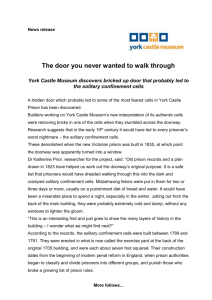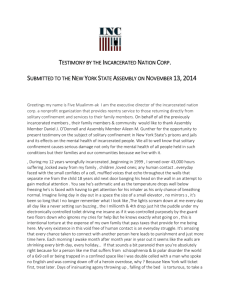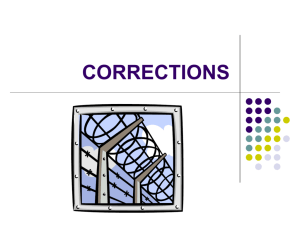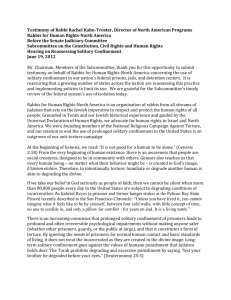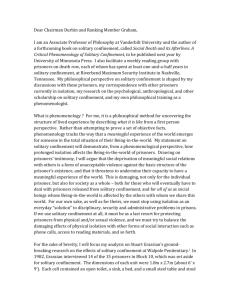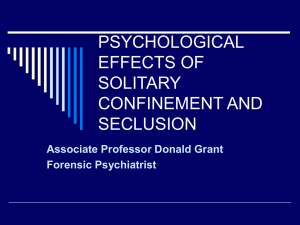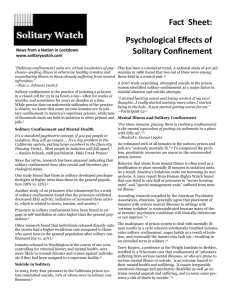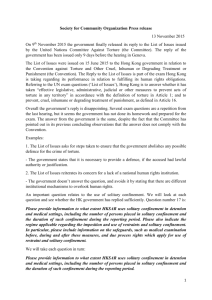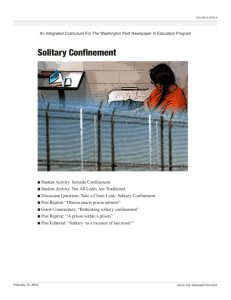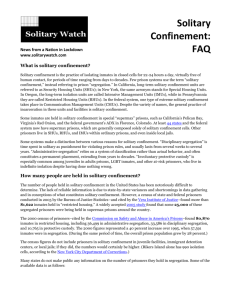Fact Sheet: Solitary Confinement and the Law
advertisement
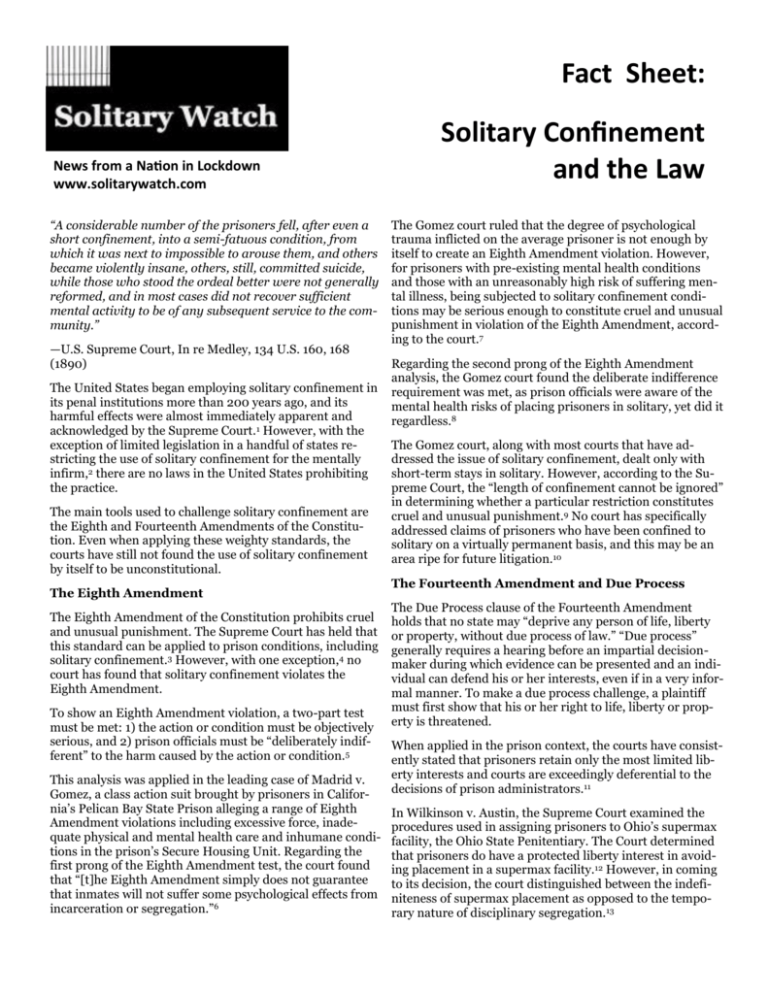
Fact Sheet: News from a Nation in Lockdown www.solitarywatch.com “A considerable number of the prisoners fell, after even a short confinement, into a semi-fatuous condition, from which it was next to impossible to arouse them, and others became violently insane, others, still, committed suicide, while those who stood the ordeal better were not generally reformed, and in most cases did not recover sufficient mental activity to be of any subsequent service to the community.” —U.S. Supreme Court, In re Medley, 134 U.S. 160, 168 (1890) The United States began employing solitary confinement in its penal institutions more than 200 years ago, and its harmful effects were almost immediately apparent and acknowledged by the Supreme Court.1 However, with the exception of limited legislation in a handful of states restricting the use of solitary confinement for the mentally infirm,2 there are no laws in the United States prohibiting the practice. The main tools used to challenge solitary confinement are the Eighth and Fourteenth Amendments of the Constitution. Even when applying these weighty standards, the courts have still not found the use of solitary confinement by itself to be unconstitutional. The Eighth Amendment The Eighth Amendment of the Constitution prohibits cruel and unusual punishment. The Supreme Court has held that this standard can be applied to prison conditions, including solitary confinement.3 However, with one exception,4 no court has found that solitary confinement violates the Eighth Amendment. To show an Eighth Amendment violation, a two-part test must be met: 1) the action or condition must be objectively serious, and 2) prison officials must be ―deliberately indifferent‖ to the harm caused by the action or condition.5 This analysis was applied in the leading case of Madrid v. Gomez, a class action suit brought by prisoners in California’s Pelican Bay State Prison alleging a range of Eighth Amendment violations including excessive force, inadequate physical and mental health care and inhumane conditions in the prison’s Secure Housing Unit. Regarding the first prong of the Eighth Amendment test, the court found that ―[t]he Eighth Amendment simply does not guarantee that inmates will not suffer some psychological effects from incarceration or segregation.‖6 Solitary Confinement and the Law The Gomez court ruled that the degree of psychological trauma inflicted on the average prisoner is not enough by itself to create an Eighth Amendment violation. However, for prisoners with pre-existing mental health conditions and those with an unreasonably high risk of suffering mental illness, being subjected to solitary confinement conditions may be serious enough to constitute cruel and unusual punishment in violation of the Eighth Amendment, according to the court.7 Regarding the second prong of the Eighth Amendment analysis, the Gomez court found the deliberate indifference requirement was met, as prison officials were aware of the mental health risks of placing prisoners in solitary, yet did it regardless.8 The Gomez court, along with most courts that have addressed the issue of solitary confinement, dealt only with short-term stays in solitary. However, according to the Supreme Court, the ―length of confinement cannot be ignored‖ in determining whether a particular restriction constitutes cruel and unusual punishment.9 No court has specifically addressed claims of prisoners who have been confined to solitary on a virtually permanent basis, and this may be an area ripe for future litigation.10 The Fourteenth Amendment and Due Process The Due Process clause of the Fourteenth Amendment holds that no state may ―deprive any person of life, liberty or property, without due process of law.‖ ―Due process‖ generally requires a hearing before an impartial decisionmaker during which evidence can be presented and an individual can defend his or her interests, even if in a very informal manner. To make a due process challenge, a plaintiff must first show that his or her right to life, liberty or property is threatened. When applied in the prison context, the courts have consistently stated that prisoners retain only the most limited liberty interests and courts are exceedingly deferential to the decisions of prison administrators.11 In Wilkinson v. Austin, the Supreme Court examined the procedures used in assigning prisoners to Ohio’s supermax facility, the Ohio State Penitentiary. The Court determined that prisoners do have a protected liberty interest in avoiding placement in a supermax facility.12 However, in coming to its decision, the court distinguished between the indefiniteness of supermax placement as opposed to the temporary nature of disciplinary segregation.13 Regarding disciplinary segregation, the Court ruled in Sandin v. Conner that prisoners have no liberty interest in being taken out of the general prison population and temporarily placed in administrative segregation because the nature of the conditions in solitary ―did not present a dramatic departure from the basic conditions of [the inmate’s] sentence.‖14 The Court implied that if a transfer were to impose ―atypical and significant hardship on the inmate in relation to the ordinary incidents of prison life‖ a liberty interest may be found, however no definitive baseline for that standard has yet been defined.15 on the issue. After a decision is made, a short statement of reasons must be provided.16 The Supreme Court has also ruled that meaningful periodic hearings must be held to ensure that administrative segregation is not a ―pretext for indefinite confinement.‖17 Scholars and advocates express concerns that in the supermax context, any periodic hearing held is a mere formality without any true review of the individual’s situation.18 Were a claimant to definitively show that these reviews were a sham or the outcome was predetermined, it would be a violation of due process.19 International Standards The Supreme Court acknowledges that its interpretation of the Eighth Amendment must not be ―static‖20 and the Court is increasingly looking to international standards to define ―cruel and unusual punishment.‖ 21 Herman Wallace’s drawing of his cell at the Louisiana State Penitentiary, Angola. Wallace has been in solitary confinement for 39 years. If a liberty interest is implicated, adequate due process must then be provided. In Wilkinson, the Supreme Court required that a prisoner be given a statement of reasons for why he or she is being assigned to a supermax facility and there be an opportunity for the prisoner to be heard European bodies have taken a particularly progressive view on the use of solitary confinement, allowing it only after a medical examination certifies the prisoner fit to sustain the isolation and with daily monitoring of the prisoner’s psychological state.22 Additionally, the Council of Europe’s European Committee for the Prevention of Torture stated that solitary confinement can rise to the level of inhuman and degrading treatment and ―should be as short as possible.‖23 The Committee Against Torture — the governing body of the Convention Against Torture, to which the United States is a party — has recommended that solitary confinement be abolished entirely because of its potentially harmful effects on prisoners’ mental and physical health.24 1. Lobel, J. (2008), ―Prolonged Solitary Confinement and the Constitution,‖ Journal of Constitutional Law, 11: 118-119. 6. Madrid v. Gomez, 889 F.Supp. 1146, 1264 (N.D. Cal 1995). 19. See Lobel, at 126, citing Ryan v. Ill. Dep’t of Children & Family Servs., 185 F.3d 751, 762 (7th Cir. 1999) (producing ―evidence that the decision has already been made and any hearing would be a sham‖ sets forth a procedural due process claim); Patrick v. Miller, 953 F.2d 1240, 1245 (10th Cir. 1992) (holding that due process requires an impartial tribunal that has not predetermined facts); Francis v. Coughlin, 891 F.2d 43, 46 (2d Cir. 1989) (―[I]t is axiomatic that a prison disciplinary hearing in which the result is arbitrarily and adversely predetermined violates [the right of due process].‖); Wagner v. City of Memphis, 971 F. Supp. 308, 319 (W.D. Tenn. 1997) (finding that the Mayor predetermined the hearing and thus violated plaintiffs’ procedural due process rights). 7. Id. at 1265-66. 20. Trop v. Dulles, 356 U.S. 86, 101 (1958). 8. Id. at 1267. 21. Roper v. Simmons, 543 U.S. 551, 575 (2005). 9. Hutto v. Finney, 437 U.S. 678, 686 (1978). 22. Recommendation No. R (87) 3 of the Committee of Ministers to Member States on the European Prison Rules, Rs. 38(1), 38(3) (1987), available at http://www.coe.int/T/E/Legal-affairs/Legal-cooperation/Prisonsandaltematives/Legal-instruments/Rec.R(87)3.asp. 2. See National Religious Campaign Against Torture, Torture in U.S. Prisons, http://www.nrcat.org/index.php? option=com_content&task=view&id=541&Itemid=394. 3. Hutto v. Finney, 437 U.S. 678, 685 (1978). 4. Ruiz v. Johnson, 37 F. Supp. 2d 855, 914–15 (S.D. Tex. 1999) (reversed on other grounds). 5. Farmer v. Brennan, 511 U.S. 825, 834 (1994). 10. Lobel, at 120. 11. See, e.g., Hewitt v. Helms, 459 U.S. 460, 467 (1983). 23. European Comm. for the Prevention of Torture and Inhuman or Degrading Treatment or Punishment (1992), 2d General Report on the CPT’s Activities Covering the Period 1 January to 31 December 1991 56, available at http://www.cpt.coe.int/en/annual/rep-02.htm. 12. 545 U.S. 209, 220 (2005). 13. Id. at 224. 14. 515 U.S. 472, 485 (1995). Note that previously the Supreme Court had found a liberty interest in being placed in administrative segrega24. Lobel, at 123. tion (Hewitt, 459 U.S. at 470-71), however the methodology used in that case was abrogated by later cases. Fact Sheet by Jennifer Wedekind. © 2011. Please cite Solitary Watch and the original sources when quoting from this document. 15. See Wilkinson, 545 U.S. at 223. 16. Id. at 226. Contact information: Solitary Watch, PO Box 11374, Washington, DC 20008 / solitarywatchnews@gmail.com. 17. Hewitt, 459 U.S. at 477 n.9. 18. Lobel, at 125. 2
